
About Fencing
Fencing is a combat sport played between fencers using a sword for attack and self-defence. It is a fast-paced sport where the fencer strikes the opponent in the blink of an eye. The opponent fencer needs to defend the attack and launch an attack at the earliest opportunity.
The fencers try to touch each other with the tip of the sword. The fencer landing the first touch to its opponent wins points. Fencers have quick and fast reflexive action, and the speed of their sword can match the speed of a bullet.
The idea of modern fencing is to touch your sword first into the targeted area of the opponent without being hit first. As this is a fast-paced sport hence electronics is used to light up the fencer who touches the opponent first hence providing the judges and the spectators with the winner of the point.
Individual fencing matches are limited to three rounds of three minutes each. The fencer achieving the maximum number of hits or the fencer achieving a score of 15 points first wins the match.
Fencing is governed by Fédération Internationale d’Escrime (FIE). They set the rules of the sport and organise competitions around the world. Fencing is amongst the first sport played in the Olympics and has been a part of the Olympics since its inception in 1896.
Fencing Olympic 2020 logo : 
History
Sword fighting was associated with the military since early rulers. The military used to train their fighters with sword and organised competitions among themselves. The shift from military to combat sport happened in the middle of the 18th century.
Rules for this sport were formulated that included postures, the way to attack and defend along the combat area. Governed by Fédération Internationale d’Escrime (FIE), fencing has been part of the modern Olympics since its inception in 1896.
Objective
The objective of this sport is to hit the opponent fencers’ targeted area first without getting hit themselves. Each match is divided into three rounds, each comprising of three minutes. The fencer attaining the maximum points within the stipulated time or the fencer attaining 15 points first wins the match.
Fencing is a one on one sport, although fencing is also played as a team sport where individual fencers from the opposing teams engage in a match. The fencer of the team that wins the maximum number of matches is declared as the winning team.
Weapons
Fencing is a sport played with weapons. There are three different kinds of swords used for fencing that have their own rules and strategies.
Right Of Way: When both fencers hit each other at the same time, the fencer who has the attacking position or has the initial initiative or the fencer who fights more aggressively gets declared as the winner of the point.
Foil: This is the most common discipline of fencing and considered to be the most technical. Foil is the lightest of all the three weapons, the weight of a foil is 500gm, and they have a circular hand guard that protects the hands of the fencer. The target area includes the torso either in the front or at the back. Arms or legs are excluded as a part of the targeted area.
The fencer should touch the opponent with the tip of the foil to score a point. Each fencer is demarcated with a different colouring light. The light that glows first indicates that the fencer had scored a point. Touching the opponent with the side of the blade does not count as any point.
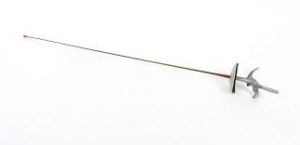
Sabre: This is the fastest discipline amongst the three. The fencer is allowed to cut or slash using the entire blade. The targeted area covers the entire upper body, including arms except for the weapon arm. The handle of a sabre is covered with a handguard, and it weighs 500 gm. As the target area increases and the entire blade of the sword can score a point attacking the best option in this discipline.

Épée: This is the slowest discipline of fencing. The sword is heavier weighing 775gm. The targeted area now covers the whole body. As a result, fencers hesitate to go for an all-out attack exposing their body. A defensive approach is taken rather than an attack. The Right Of Way rule does not apply to this discipline, and both the fencers get awarded with a point when they strike each other at the same time.

Playing Area
The fencing match takes place in a strip known as the piste. The strip is 14m long and 2m wide. A centre line demarcates the area of the two fencers. Two en-garde lines are present at a distance of 2m from the centre line where the fencers start their bout.
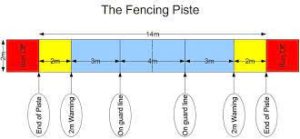
Two warning lines 2m from the finish is drawn on either side to let know the fencer that they have retreated near the end of the strip.
How The Sport Is Played
Fencers when ready for their bout stand on the en-garde lines, the referee gives them a signal to go. The clock starts immediately to keep a measure of time.
Once a fencer has scored a point, the clock stops and the fencers return to their en-garde lines for the next point and this process is repeated until the time for the round had expired. Likewise, the next rounds are progressed between the fencers.
In case of any dispute for points, the fencer can approach the referee and referee in consultation with judges provides their ruling.
The footwork of the fencer plays a major role in fencing. They need to be at the right place at the right time to carry out a successful attack. They have to manoeuvre themselves frequently out of the striking range of the attacker.
Deceleration and acceleration, and sudden changing of direction are part of the tricks in fencing. The most prominent way of attack is lunging with a sudden acceleration towards the opponent maintaining self-balance.
Equipments
Fencing is a combat sport played with different weapons; these weapons hit the target opponent at incredible speed. Hence the fencer needs a protective suit to protect them.
The protective clothing worn by fencers is made from Dyneema that is special puncture resist clothing. This clothing has the potential to resist 800 Newtons. The mask worn by fencers is strong enough to withstand twice that amount of force.
Jackets: This is the essential equipment of fencers and specially designed for them. The jackets contain a strap that slides between the legs and provides adequate protection to the fencers. They also have folded collar that protects the fencer’s weapon passing through the mask and the jacket.
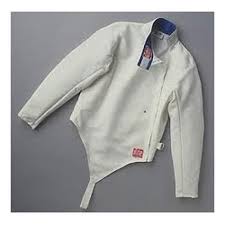
Plastron: This is an underarm protector worn by the fencer under the jacket that provides additional protection to arms and some portion of the back.
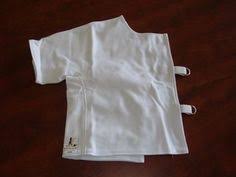
Chest Protector: This protector is worn by female fencers to protect their chest. It is made of hardened plastic and helps in protecting the upper torso.
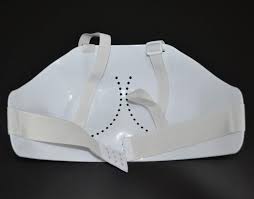
Mask: The fencing mask contains a mesh so that the fencer can view their opponents. They support about 12 kilos of mesh and can withstand a force of more than 350 Newtons. The mask also has an elongation that protects the neck. The mask should be free from holes and tear.
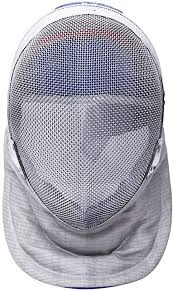
Socks: Fencing socks are long and elongated to stretch to the knee.
Shoes: Fencing shoes are reinforced on the inside in the toe, they and are flat with no sole on the outside.

Gloves: Gloves are worn by the fencer to improve grip. They also protect the weapon hand and prevent the sword from going to the sleeves.
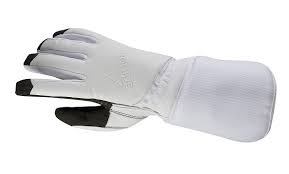
Breeches: They are short trousers that end below the knee with an overlap of 10 cm with the jacket.
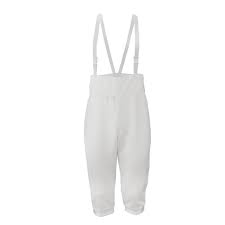
Lamé: It is a layer of electronic conductive material worn over the jacket covering the entire target area used to identify a hit with the glowing of fencer lights. Lamé is not used for Épée, as the targeted area in this discipline covers the entire body.
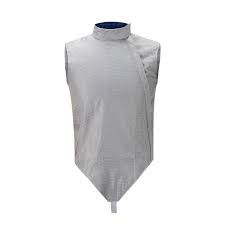
Electronic Equipment: The main component is the body cord that connects the fencer with wires for electrically detecting that the weapon has touched the opponent.
Officials
Referee: The referee is the one, who conducts the match, and it is the referee who gives the start signal to the fencers, and a match has one referee. They stand at the side of the piste and keep a close eye on the fencers. They resolve any dispute arising in the match by consulting the judges if required.
Side-judges: They sit a little away from the piste and keep a close eye on the fencers. There are two side-judge, one looking at each fencer.
Terms Associated
The entire sport of fencing is divided broadly into two different categories based on techniques attack and defence.
Attack: Attack consists of the initial offensive action by a fencer by extending its arm to thrust an attack on the opponent.
Riposte: When the attacker has completed their attack and has been parried successfully by the defender and now the defender has the opportunity to attack the attacker.
Lunge: A forward thrust by an attacker by extending the front leg with a slight kicking motion.
Feint: A false attack that provokes an opponent fencer.
Beat Attack: When an opponent beats the attacker’s blade to gain an advantage to carry out an attack.
Disengage: This is an attacking technique where the attacker fools the opponent from the first move and attacks from a different direction.
Flick: This term is used in foil and Épée as it takes the flexibility of the weapon to use it like a whip. The blade bends to hit the obscure part of the opponent to score the point.
Renewed Attack: An attack is made by the attacker immediately after the first attack is parried by the opponent.
Compound Attack: The attack preceded by one or more feints, allowing the opponent to parry, and the attacker deceives the parry to attack again.
Parry: This is a defensive technique to move and deflect the blade of the attacker’s weapon so that the attacker weapon cannot contact the targeted area.
Circle Parry: This is also a defensive technique where the weapon is moved in circles to deflect the tip of the attacker weapon away.
Fencing Rules
- The fencers should salute each other and the referee. Refusal to do so may lead to the fencer’s disqualification.
- When the referee calls en-garde, the fencers should wear their masks and take up their position on their respective en-garde lines.
- The bout starts, when the referee calls ‘Fence’.
- The referee discontinues the bout when two fencers come into physical contact with each other or when any portion of their bodies hit.
- Once a point is awarded to a fencer, the fencer should return to the en-garde line to start the next section.
- Fencing is time-bound. The timer starts when the referee calls ‘Fence’ and stops if the referee calls ‘halt’. Each bout consists of three minutes with a minute break between them.
- The bout stops after a fencer attains the score of 15 within the allocated 9 min (Three sessions of three minutes each).
- Fencers must stay put to the piste. If a fencer steps out of the piste, the referee calls a halt, and the attacker is allowed to advance one meter towards the penalised offender.
- A fencer is penalised with a card by the referee for any unwanted disruption such as not attacking or time-wasting or others.
- A fencer penalised with a yellow card is warned, and no further actions are taken. A fencer penalised with a red card is warned, and simultaneously a point is awarded to the opponent. A fencer getting penalised with a black card is excluded from the competition and expelled from the venue.
World Rankings
- Foil Ranking for Men
- Alessio Foconi

- Gerek Meinhardt

- Enzo Lefort
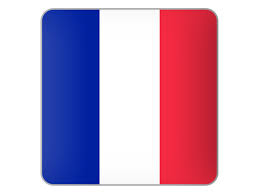
- Sabre Ranking for Men
- Sanguk Oh

- Eli Dershwitz

- Luca Coratoli

- Épée Ranking for Men
- Gergely Siklosi

- Sergey Bida

- Igor Reizelin

- Foil Team Ranking for Men
- USA

- France

- Italy

- Sabre Team Ranking for Men
- Korea

- Hungary

- Italy

- Épée Team Ranking for Men
- France

- Italy

- Ukraine

- Foil Ranking for Women
- Inna Deriglazova

- Elisa Di Francisca

- Ysaora Thibus

- Sabre Ranking for Women
- Olga Kharlan

- Sofiya Velikaya

- Manion Brunet

- Épée Ranking for Men
- Ana Maria Popescu

- Injeong Choi

- Yiwen Sun





 (2 votes, average: 5.00 out of 5)
(2 votes, average: 5.00 out of 5)


